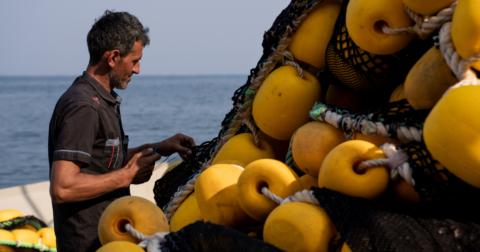Solutions
Urban Foragers Are Mapping Edible Plants Around the World
Climate•5 min read
Explainer
Commercial fishing is destroying ecosystems around the world. Is anything being done about it?


Words by Seth Millstein
The global population is projected to hit at least 8.5 billion people by the end of the decade. As more of us become aware of the disastrous environmental impacts of livestock production, some climate-conscious consumers are turning to seafood as an alternative to meat. But the seafood industry has its own problems, as the rise of overfishing — and its harms — has made clear.
“Overfishing is a serious global problem, threatening ocean wildlife and biodiversity, as well as seafood supplies,” Dr. Beth Polidoro, Director of Research at the Marine Stewardship Council, told Sentient in a statement. “And unfortunately, it’s a problem that’s increasing, and has been for several decades.”
Seafood consumption has risen dramatically since the mid-20th century: Between 1961 and 2021, the average person went from eating around 20 pounds of seafood every year to around 44 pounds, according to Our World in Data. Since then, commercial fishing has become a $229 billion industry, and according to a 2019 study, between 1.1 and 2.2 trillion fish are caught every year.
But as our appetite for seafood has increased, so has the frequency of overfishing. Between 1974 and 2017, the share of the world’s oceans that were overfished jumped from 10 percent to a little over 34 percent, according to the Food and Agriculture Organization of the United Nations. Marine ecosystems around the world have suffered as a result.
But what exactly is overfishing, why is it such a big problem — and what can be done about it? Let’s dive in.
Broadly speaking, overfishing is when fish in a particular region are caught at a faster rate than they can repopulate. In theory, this could ultimately lead to the extinction of the species, although in practice, it isn’t clear that any fish species is confirmed to have gone extinct solely due to overfishing — although this might soon change, as we’ll see.
Overfishing is directly related to the concept of yields. For any fish population, there’s an “ideal” amount of fishing that maximizes the number of fish that can be caught in the long-term. Overfishing is simply when the fish in a region are caught at a faster rate than this amount.
“If you don’t fish at all, you obviously don’t get any long-term catch,” Ray Hilborn, professor at the University of Washington’s School of Aquatic and Fishery Sciences, tells Sentient. “If you fish too hard, you get very little long-term catch. And in the middle is this theoretical sweet spot that produces what’s called ‘maximum sustainable yield.’”
Hilborn says that in general, the maximum sustainable yield of a given fish population is “roughly equal to the fraction of fish who would die from natural mortality.” For example, if 20 percent of the fish in a certain population would die from natural causes over the course of the year, this implies that fishers shouldn’t catch more than 20 percent of that fish over that same period of time.
In contrast, you can look at the overfishing that occurred on Canada’s northeast coast throughout the 20th century. Canadian cod was harvested so over-aggressively that by 1992, the region’s cod population had fallen to less than one percent of its historic norm.
To ensure the species wasn’t wiped out completely, the Canadian government announced a moratorium on cod fishing in the region, a decision that resulted in 30,000 people losing their jobs. And yet, the cod population in the area still hasn’t recovered.
Overfishing is often grouped under the larger umbrella of illegal, unreported and unregulated fishing, (or IUU), by scientists, academics and policymakers.
Overfishing has a number of deleterious environmental impacts. Some of them, like bycatch, are inherent problems with fishing in general that are exacerbated by overfishing practices; others, like trophic cascades, are specifically caused by overfishing.
Ecosystems involve a complex web of interactions between different species, and in a healthy ecosystem, these interactions naturally balance themselves out in a sustainable way. If predators become too populous, there won’t be enough prey to feed them, so some of the predators will die off, which then gives the prey species time to repopulate. This repopulation gives the predators more access to food, thus allowing their species to repopulate, and so the cycle repeats itself.
Overfishing disrupts this natural process, and the consequences can be varied and far-reaching.
Take, for instance, the relationship between parrotfish, coral reefs and algae. Algae thrives in coral, but when it’s allowed to grow unchecked, it can damage and kill the coral species. Luckily, parrotfish dine on algae, and so by simply going about their lives, they play an accidental but very important role in maintaining the health of coral reefs.
But when parrotfish are overfished and their population dwindles, this check on algae growth is removed, and the coral reefs suffer. This isn’t just hypothetical: A study published in 2015 found that overfishing of parrotfish and other “grazers” has been a primary driver of the steep decline in the health of Caribbean coral reefs over the last 50 years.
This type of phenomenon, in which a change in a predator’s population has a downstream effect not only on its own prey but on other species as well, is what’s known as a trophic cascade. And overfishing has caused a number of trophic cascades.
The overfishing of sharks on the Atlantic coast led to a collapse in scallop populations, for instance, because sharks eat clownrays and clownrays eat scallops. Overfishing of cod and other sea urchin predators has helped degrade kelp forests, which is an especially big problem given the many environmental benefits that kelp provides.
One of those benefits is the absorption of carbon dioxide from the atmosphere, which brings us to another dire consequence of overfishing: rising global temperatures.
The idea that overfishing can exacerbate climate change might sound counterintuitive; after all, what do the number of fish in the sea have to do with the temperature outside? As it turns out, quite a bit.
The ocean absorbs a massive amount of carbon dioxide from the atmosphere: around three billion metric tons every year, or one-third of all global emissions. What’s more, the ocean absorbs more carbon than it releases, which makes it a carbon sink — the world’s biggest, in fact. Because carbon dioxide is one of the primary greenhouse gasses, the ocean plays an enormous and crucial role in slowing the rise of global temperatures.
But overfishing has diminished the ocean’s ability to absorb carbon. That’s because ultimately, it’s the creatures in the ocean who are sucking up all of this carbon.
The process begins when phytoplankton at the ocean’s surface absorb carbon dioxide from the air. These microscopic creatures are then eaten by zooplankton and other larger species, who absorb the phytoplankton’s carbon, and so it goes throughout the ocean’s food web — all the way up to whales, who can store up to 33 tons of carbon dioxide over the course of their lives.
This is an effective form of carbon storage, because the carbon remains in the ocean and out of Earth’s atmosphere even after the fish die — unless, of course, the fish are caught by humans and removed from the ocean, in which case all of that carbon is released back into the air. Overfishing greatly exacerbates this phenomenon: According to a Sentient analysis, overfishing results in an additional 5.6 million metric tons of CO2 being released into the atmosphere every year.
Bycatch is what happens when fishers accidentally catch, injure or kill species that they weren’t intending to catch. Common victims of bycatch include dolphins, sea turtles and over 200 other species that are protected, endangered or threatened.
The sheer extent of bycatch can’t be overstated: It’s been estimated that over 40 percent of all fish caught annually are actually bycatch. What’s more, bycatch results in the death of more than 650,000 marine mammals — that is, aquatic creatures other than fish — every year.
Many coastal communities around the world rely on a healthy supply of local fish to feed themselves. Overfishing and other forms of illegal, unreported and unregulated fishing have hurt these communities in a number of ways, and it’s often developing countries that suffer.
In Sierra Leone, for example, overfishing in coastal waters has forced local fishers to travel further and further into the sea to catch fish, exposing them to increasingly dangerous weather conditions. In 2022, Sierra Leonean fishers told the Guardian that they’re struggling to feed their families thanks to the dearth of fish caused by overfishing.
Much of the time, the overfishing causing this is carried out by foreign nations. In Japan and South Korea, for instance, more fish is caught by other countries’ vessels than by domestic fleets. In Sierra Leone, most of the large trawlers used to harvest fish are owned by European and Asian companies, according to the United Nations, and 40 percent of industrial fishing licenses in the country are owned by Chinese vessels.
As mentioned earlier, no fish species is confirmed to have gone extinct solely because it was subject to overfishing. But that may not always be the case: A 2021 study by the World Wildlife Foundation concluded that one-third of all shark, ray and chimaera species are currently at risk of going extinct thanks to overfishing.
Governments around the world spend a lot of money subsidizing their respective countries’ fishing industries. Though some of these subsidies are benign, others have been blamed for incentivizing overfishing and contributing to all of the above problems. For instance, many governments subsidize or discount the fuel for shipping vessels, allowing them to fish longer, harder and farther away.
The world’s governments spend over $20 billion on what researchers call “harmful fishing subsidies” every year, according to a 2019 study in the journal Marine Policy. Eliminating, or even substantially reducing, these subsidies would go a long way to curb overfishing, according to a range of experts and marine advocates.
Marine Protected Areas (MPAs) are areas of the ocean in which legal protections have been established for conservationist purposes. The nature and degree of these protections vary, but many of them have been effective at reducing or eliminating overfishing within their boundaries.
However, MPAs only cover a miniscule portion of the ocean. According to the UN, less than nine percent of the ocean is protected by MPAs — and that’s one of the higher estimates. The Marine Conservation Institute puts the number at around five percent, while a 2024 report by a group of NGOs claimed that, due to lax enforcement and weak protections in some MPAs, only 2.8 percent of the ocean is effectively protected from overfishing.
Regardless of which estimate is most accurate, the upshot is clear: Over 90 percent of the ocean is unprotected. Bolstering MPA enforcement and bringing more of the sea under legal protections — which the UN, to its credit, is currently attempting to do — would be another powerful check against overfishing.
One factor driving overfishing is that consumers are increasingly developing a voracious appetite for seafood. Some coastal communities are dependent on fish for their diet, but the rest of us can be mindful of overconsumption, and how it impacts wildlife, including fish and other marine life. One alternative: the many sources of plant-based protein that don’t exact anywhere near the environmental cost of seafood (or meat, for that matter).
Although it has become increasingly popular to think of fish as a sustainable alternative to meat, the far-reaching environmental, animal and human impacts of persistent overfishing throws a wrench into that narrative. If industrial fishing operations continue at their current pace, so will overfishing — at high cost to marine habitats and our ability to stave off the worst effects of global warming.